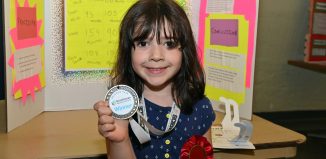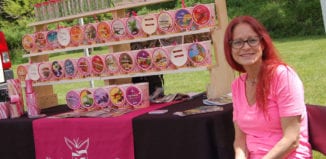BNL’s Anibal Boscoboinik, visiting students score wins in ways to trap noble gases

By Daniel Dunaief
It’s been a banner year for ideas and potential products that trap noble gases at Brookhaven National Laboratory. So-named for their full complement of electrons, noble gases tend to be less reactive than other atoms that can add electrons to their outer shells.
While their name sounds grandiose, these gases are anything but, particularly when people inhale the radioactive and prevalent gas radon, which can cause lung cancer or when the decay of uranium into xenon makes a nuclear reactor less efficient.
When he was studying how hydrocarbons react at the active site of zeolite models, Brookhaven National Laboratory’s material scientist Anibal Boscoboinik made an accidental discovery about a decade ago that some nanomaterials, which are incredibly small, trap these gases.
Among several other projects he’s working on, Boscoboinik has since studied these nanocages, learning about the trapping mechanism and making variations of these materials and trapping methods that can be useful for a wide range of applications.
The Battelle Memorial Institute, which partners with Stony Brook University to form Brookhaven Science Associates and manages nine national labs across the country, named Boscoboinik an “inventor of the year” for his work developing these materials.
Battelle awards an inventor of the year to a researcher from each institution under its management, recognizing efforts that contribute to science or engineering and that can have a positive impact on society.
“It feels really good to be recognized for the work,” said Boscoboinik, who is proud of the many people who made this progress possible directly and indirectly. “It would be amazing if we get to see something that stemmed from an accidental discovery doing very basic fundamental research becoming a real-life application that can benefit society.”
At the same time, three students from minority serving institutions were selected to receive seed grants as a part of MSI (for Minority Serving Institutions) Connect at BNL, in which they seek to commercialize a way to remove radon from the air.
They may work in a business to business model to supply other companies that can incorporate their materials into products.
The students, Jeremy Lopez Flores and Oscar Rivera-Cruz from the University of Puerto Rico and Alexander Bailey from West Virginia State University, will enter phase 2 in the process. The next phase of funding comes from other sources, such as FedTech. Boscoboinik will advise the students as they develop the company and any potential products.
These undergraduate students are looking to remove radon from the air at a concentration of four picocuries per liter, which is equivalent to smoking eight cigarettes a day.
“I am certainly pleased that the value of our collective output was recognized,” said Bailey, who is from St. Albans, West Virginia, in an email. Bailey, a sophomore double majoring in chemistry and math, plans to attend graduate school after completing his undergraduate studies.
Rivera-Cruz, who is a senior majoring in Cellular and Molecular Biology, appreciated the guidance from Boscoboinik, whom he described in an email as an “incredible resource for the team” and suggested that the team was “extremely grateful and lucky” to have Boscoboinik’s support.
In other research
As a staff member at the Center for Functional Nanomaterials, Boscoboinik spends half his time working with scientists from around the world who come to the CFN to conduct experiments and half his time working on his own research.
The process of granting time to use the facilities at BNL is extremely competitive, which means the projects he works on with other scientists are compelling. “While I help them with their research, I get to learn from them,” he said.
Boscoboinik regularly works with the group of Professor Guangwen Zhou from Binghamton University. In recent work, they explored the dynamics of peroxide formation on a copper surface in different environments.
In his own work, Boscoboinik is also interested in trying to help the nuclear energy community.
During the breakdown of radioactive uranium, the process heats up water in a tank, moving a turbine that produces energy.
The breakdown of uranium, however, produces the noble gas xenon, which is a neutron absorber, making reactors less efficient.
Boscoboinik anticipates that any new product that could help the field of nuclear energy by removing xenon could be a decade or more away. “This is a highly regulated industry and changes in design take a very long time,” he explained.
Boscoboinik is also collaborating with researchers from Johns Hopkins University on metal organic frameworks. Some molecules pass through these frameworks more rapidly than others, which could enable researchers to use these frameworks to separate out a heterogeneous collection of molecules.
Additionally, he is developing processes to understand dynamic conditions that affect different types of reactions. At this point, he has been looking at the oxidation of carbon monoxide, which he called the “drosophila” of surface science for its widespread use and versatility, to develop the methodology. In oxidation, carbon monoxide mixes with oxygen to make carbon dioxide.
In his work, Boscoboinik has collaborated with Qin Wu, who deploys artificial intelligence to interpret the data he generates in his experiments.
The long-term plan is to develop complex-enough algorithms that suggest experiments based on the analysis and interpretation of data.
Outside the lab
Boscoboinik is a part of a collaborative effort to combine science and music. “We use music as a way to enable conversations between scientists and the general public” to help make the sometimes complex and jargon-laden world of science more accessible, he said.
In Argentina, research groups have taken famous musicians to the lab to perform concerts while encouraging conversations about science. During the course of their visits, the musicians speak with scientists for the benefit of the public. In prior seasons, the musicians used popular songs to relate to the research the scientists they interview do. Part of the plan is to make new songs related to the research.
Boscoboinik is part of a collaboration between Music for Science, the network of Argentinian scientists abroad, and the Argentinian diplomatic missions, including the embassies and the consulates. At some point in the future he may create a show that relates noble gases and music.
As with his some of his scientific work, the connection between music and research is a developing proof of concept that he hopes has broader appeal over time.






